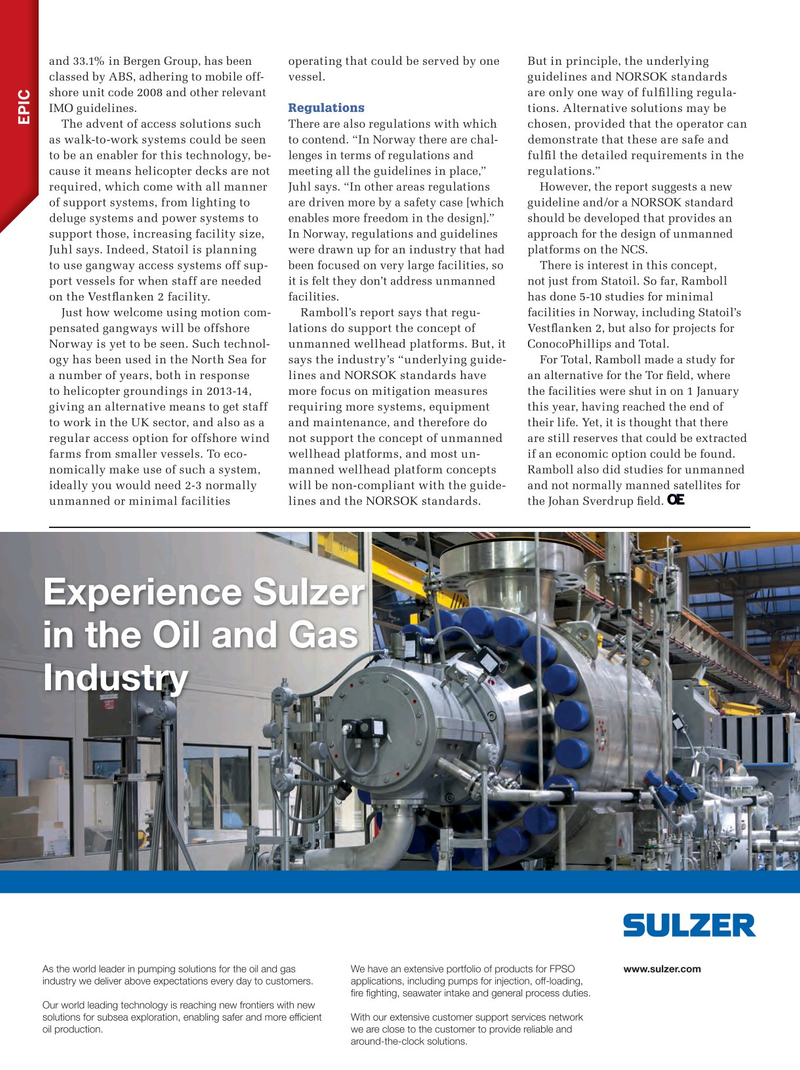
Page 36: of Offshore Engineer Magazine (Aug/Sep 2016)
Read this page in Pdf, Flash or Html5 edition of Aug/Sep 2016 Offshore Engineer Magazine
and 33.1% in Bergen Group, has been operating that could be served by one But in principle, the underlying classed by ABS, adhering to mobile off- vessel. guidelines and NORSOK standards shore unit code 2008 and other relevant are only one way of ful? lling regula-
Regulations tions. Alternative solutions may be
IMO guidelines.
EPIC
The advent of access solutions such
There are also regulations with which chosen, provided that the operator can as walk-to-work systems could be seen to contend. “In Norway there are chal- demonstrate that these are safe and to be an enabler for this technology, be- lenges in terms of regulations and ful? l the detailed requirements in the cause it means helicopter decks are not meeting all the guidelines in place,” regulations.” required, which come with all manner
Juhl says. “In other areas regulations However, the report suggests a new of support systems, from lighting to are driven more by a safety case [which guideline and/or a NORSOK standard deluge systems and power systems to enables more freedom in the design].” should be developed that provides an
In Norway, regulations and guidelines approach for the design of unmanned support those, increasing facility size,
Juhl says. Indeed, Statoil is planning were drawn up for an industry that had platforms on the NCS. been focused on very large facilities, so There is interest in this concept, to use gangway access systems off sup- port vessels for when staff are needed it is felt they don’t address unmanned not just from Statoil. So far, Ramboll on the Vest? anken 2 facility. facilities. has done 5-10 studies for minimal
Ramboll’s report says that regu- facilities in Norway, including Statoil’s
Just how welcome using motion com- lations do support the concept of
Vest? anken 2, but also for projects for pensated gangways will be offshore unmanned wellhead platforms. But, it
ConocoPhillips and Total.
Norway is yet to be seen. Such technol- says the industry’s “underlying guide-
For Total, Ramboll made a study for ogy has been used in the North Sea for lines and NORSOK standards have an alternative for the Tor ? eld, where a number of years, both in response more focus on mitigation measures the facilities were shut in on 1 January to helicopter groundings in 2013-14, requiring more systems, equipment this year, having reached the end of giving an alternative means to get staff and maintenance, and therefore do their life. Yet, it is thought that there to work in the UK sector, and also as a not support the concept of unmanned are still reserves that could be extracted regular access option for offshore wind wellhead platforms, and most un- if an economic option could be found. farms from smaller vessels. To eco- manned wellhead platform concepts
Ramboll also did studies for unmanned nomically make use of such a system, will be non-compliant with the guide- and not normally manned satellites for ideally you would need 2-3 normally lines and the NORSOK standards. the Johan Sverdrup ? eld. unmanned or minimal facilities
Experience Sulzer in the Oil and Gas
Industry
As the world leader in pumping solutions for the oil and gas We have an extensive portfolio of products for FPSO www.sulzer.com industry we deliver above expectations every day to customers. applications, including pumps for injection, off-loading, fire fighting, seawater intake and general process duties.
Our world leading technology is reaching new frontiers with new solutions for subsea exploration, enabling safer and more efficient With our extensive customer support services network oil production. we are close to the customer to provide reliable and around-the-clock solutions.
036_OE0816_Epic1_unmanned.indd 38 7/24/16 11:04 AM

 35
35

 37
37